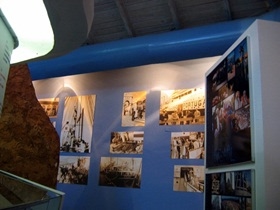Faded clippings with articles and old documents are displayed on a wall of the museum, witnessing the history of the refugees . One wall of the Museo Judio contains faded news clippings such as a May 11, 1940, article from the New York Times entitled “Exiles on Last Lap to Dominican Site,” while another showcases sepia prints by La Nación photographer Kurt Schnitzer and original paintings by artist Ernesto Loher — both children of Jewish refugees who settled in Sosua.
There’s also a colorful stained-glass Star of David and a chart extending from ceiling to floor, listing the names of settlers, the date each arrived and their country of origin. Artifacts on display include a large wooden menorah crafted by hand in the colony’s carpentry shop; a scale used in Erich Sygal’s pharmacy; an original telephone switch from the Dorsa offica; a branding iron used to mark cattle, and a metal milk container from the Productos Sosua dairy.








 Upon arriving to the island, Mr. Hess soon departed to the capital of the Dominican Republic, Santo Domingo. There he found a job as a teacher and translator. He later worked for the DORSA, and soon became a main contact between the Jewish community and the local government. Mr. Hess was the first Jew to marry a non Jewish local from the Dominican Republic, and was highly criticized by his community. Despite that, he became a teacher and later the director of the Cristobal Colon school, that was later renamed Luis Hess, in honor of Don Luis. Mr. Hess passed away on February 8, 2010 and he was 102 years old. Sosua`s beloved honorary citizen was buried next to his wife, Ana Julia.
Upon arriving to the island, Mr. Hess soon departed to the capital of the Dominican Republic, Santo Domingo. There he found a job as a teacher and translator. He later worked for the DORSA, and soon became a main contact between the Jewish community and the local government. Mr. Hess was the first Jew to marry a non Jewish local from the Dominican Republic, and was highly criticized by his community. Despite that, he became a teacher and later the director of the Cristobal Colon school, that was later renamed Luis Hess, in honor of Don Luis. Mr. Hess passed away on February 8, 2010 and he was 102 years old. Sosua`s beloved honorary citizen was buried next to his wife, Ana Julia.











